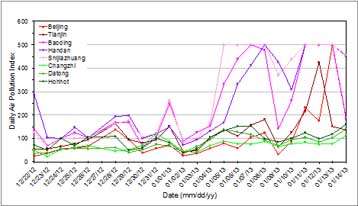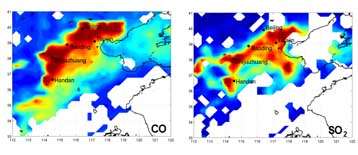First infrared satellite monitoring of peak pollution episodes in China

Plumes of several anthropogenic pollutants (especially particulate matter and carbon monoxide) located near ground level over China have for the first time been detected from space. The work was carried out by a team at the Laboratoire Atmosphères, Milieux, Observations Spatiales (CNRS / UPMC / UVSQ) in collaboration with Belgian researchers and with support from CNES, using measurements by the IASI infrared sounder launched on board the MetOp satellite. Their groundbreaking results are published online on the website of the journal Geophysical Research Letters dated 17 January 2014.. They represent a crucial step towards improved monitoring of regional pollution and forecasting of local pollution episodes, especially in China.
Despite efforts by the Chinese government to reduce surface emissions, China is repeatedly affected by major air pollution episodes. This has become an important public health issue, since air pollution causes more than 300,000 premature deaths in China each year. In January 2013, Beijing suffered an unprecedented pollution episode, mainly due to seasonal coal consumption and unfavorable weather conditions (lack of wind plus temperature inversion) that trapped the pollutants at ground level. In many regions, atmospheric concentrations of particulate matter (PM) reached values considered harmful to human health, sometimes exceeding the daily threshold recommended by the World Health Organization (25 µg/m3) by a factor of nearly 40.
To monitor local and regional pollution, China has an air quality monitoring network that continuously provides measurements of key pollutants including PM, carbon monoxide (CO) and sulfur dioxide (SO2). However, the geographical distribution of measuring stations is patchy, which makes it difficult to predict the development of pollution episodes. In this context, satellite observations prove to be extremely valuable due to their excellent geographical coverage and horizontal resolution. Unfortunately, such measurements have the disadvantage of being sensitive principally at altitudes of 3 to 10 km. Using satellites to determine atmospheric composition near ground level was complicated until now.
The researchers have shown that, contrary to expectations, the IASI sounder is able to detect plumes of pollutants even near ground level as long as two conditions are met: weather conditions must be stable, which leads to a build-up of pollutants at ground level, and there must be a significant temperature difference between the ground and the air just above the Earth's surface. In January 2013, IASI measured very high concentrations of anthropogenic pollutants such as CO, SO2, ammonia (NH3) and ammonium sulfate aerosols over Beijing and neighboring cities. The IASI infrared sounder thus proves to be well suited to monitoring these pollutants in such conditions.

This work represents a breakthrough in pollution monitoring from space. With the launch of IASI-B, two IASI sounders are now able to collect infrared data from space and twice as much information has therefore been available since the end of January 2013. It will henceforth be possible to monitor pollution episodes associated with stable weather conditions more accurately and regularly. The work opens up new prospects for improved assessment and management of air quality.
More information: First simultaneous space measurements of atmospheric pollutants in the boundary layer from IASI: a case study in the North China Plain, Anne Boynard, Cathy Clerbaux, Lieven Clarisse, Sarah Safieddine, Matthieu Pommier, Martin Van Damme, Sophie Bauduin, Charlotte Oudot, Juliette Hadji-Lazaro, Daniel Hurtmans and Pierre-Francois Coheur, Geophys. Res. Lett., Online 17 January 2014. DOI: 10.1002/2013GL058333
Journal information: Geophysical Research Letters
Provided by CNRS




















